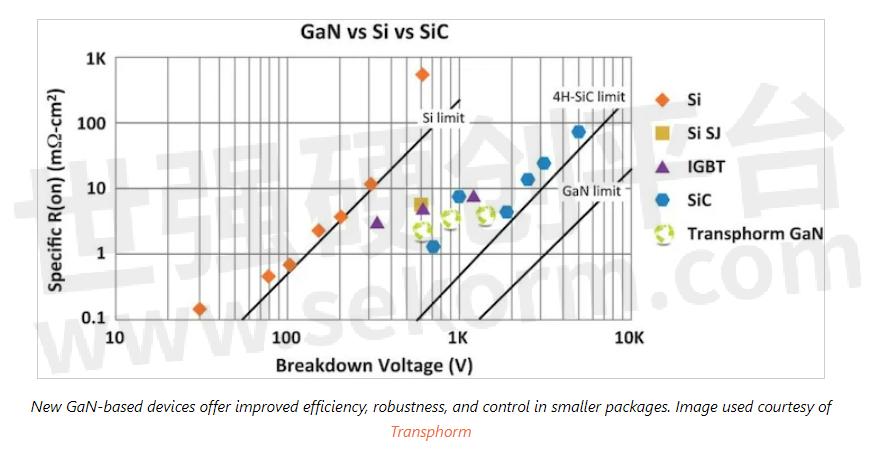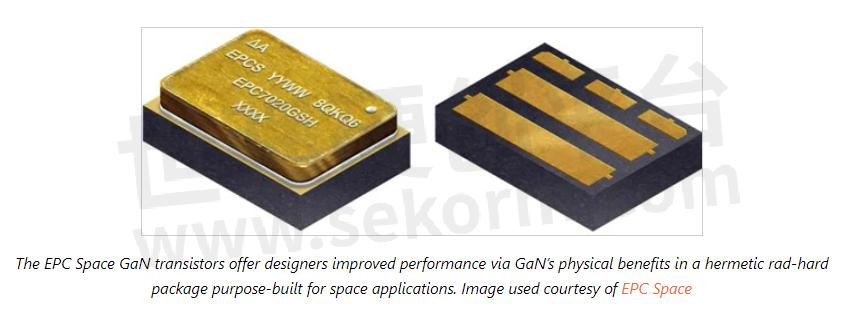EPC Space Brings GaN to the Edge of the Atmospherem, and Rohm Hones In on GaN Miniaturization

Bringing GaN to the final frontier, EPC Space introduced two new radiation-hardened GaN transistors for high-current switching in space-based applications. As the number of commercial satellites continues to increase, designers require more options for space-ready power electronics with improved current handling.
Whether in space or on the ground, these GaN-based transistors unlock new benefits compared to silicon.
Three organizations have released new GaN power transistors last month that make considerable strides in efficiency, robustness, and applicability for unique environments.

The power electronics field imposes unique demands on the next generation of high-voltage, high-current transistors—particularly for switching power supplies or motor drives. As such, new GaN transistors allow electronics to operate in new environments with comparable performance to SiC or IGBT technology.
This article takes a closer look at three summer releases of GaN transistors and gives readers a sense of how each one can benefit designers and shape the future of high-power devices.
Transphorm Focuses on Robustness in New GaN Transistor
Kicking off this roundup is the latest GaN power transistor from Transphorm, with a reported short-circuit robustness of up to five microseconds for future power inverters. As electric motors become more commonplace, many designers are concerned about the ability of GaN power electronics to withstand short circuit scenarios with both high voltage and current. To this end, Transphorm claims its power transistor is an important step toward robust GaN inverters.

When responding to short circuits, a system’s control electronics may take up to a few microseconds to remove power. As a result, the power electronics must withstand the short until power is removed. Previous generations of GaN devices have only shown short circuit robustness on the order of hundreds of nanoseconds, limiting the practical application of GaN devices. With the latest Transphorm device, however, designers can now remove power before any transistors are irreparably damaged.
Transphorm plans to present more details about the transistor at a major power electronics conference in 2024. We do know, however, that the transistor itself uses a cascode architecture to improve the robustness of the device and offer other improvements compared to enhancement-mode devices.
EPC Space Brings GaN to the Edge of the Atmosphere
Bringing GaN to the final frontier, EPC Space introduced two new radiation-hardened GaN transistors for high-current switching in space-based applications. As the number of commercial satellites continues to increase, designers require more options for space-ready power electronics with improved current handling.

The two new transistors, the EPC7020G and EPC7030G, are housed in hermetic packaging for a small yet robust footprint. Both can handle 200 A pulses and join the existing EPC70XX family of GaN transistors.
The EPC7020G can withstand up to 200 V with a 14.5 mΩ on resistance, and the EPC7030G withstands 300 V with a 32 mΩ on resistance. While EPC Space targets power supplies, motor drives, and various other instrumentation tasks as primary beneficiaries of the new rad-hard GaN devices, applications could extend far beyond those listed if the GaN devices show enough improvement over rad-hard silicon MOSFETs.
ROHM Hones In on GaN Miniaturization
Finally, in an effort to improve both power and area efficiency, Rohm Semiconductor has developed two 650 V GaN power stages with built-in GaN HEMTs and gate drivers for smaller and simpler solutions compared to silicon.
Both of the new power stages, the BM3G007 and BM3G015, support up to 650 V with a corresponding 70 mΩ and 150 mΩ on resistance, respectively. Where the new chips shine, however, is the improved efficiency compared to their silicon counterparts.

Rohm has reported a 55% lower loss and 99% reduced volume when using its power stage ICs compared to discrete silicon FETs, giving much more headroom when designing compact electronics. GaN’s inherently faster switching speeds simultaneously reduce the size of the GaN devices and external passive components.
Both power stages are available now, alongside evaluation boards for the modules.
The GaN Maturation Process Continues
Although GaN isn’t a one-size-fits-all solution for electrical engineers, its physical differences compared to silicon certainly make it a viable contender for smaller and more efficient power electronics. Especially when comparing the relative ages of silicon and GaN-based devices, GaN still has a bright future of innovation ahead. As GaN processes mature, the material itself may form the foundation for more efficient power supplies, motor drives, and many more high-power electronics.
- +1 Like
- Add to Favorites
Recommend
- EPC Releases Lowest On-resistance Rad-hard eGaN FET EPC7019 for Demanding Space Applications, 20 Times Smaller
- GaN Transistors from EPC Bring Newest Rad Hard Technology to Demanding Space Applications
- Rad Hard GaN Transistors Offering Highest Density and Efficiency on the Market for Demanding Space Applications Available from EPC
- EPC Launches 40V Rad Hard GaN FETs That Set New Performance Standards for Demanding Space Applications
- The Power and Evolution of GaN: Bringing Precision Control to Surgical Robots with eGaN FETs and IC
- How GaN is Revolutionizing Motor Drive Applications
- EPC Releases Phase 14 Report on GaN Reliability and the Use of Physics-Based Models to Project eGaN Device Lifetime
- Efficient Energy Technology’s SolMate Adopts EPC GaN, Doubling Efficiency and Extending Product Lifetime
This document is provided by Sekorm Platform for VIP exclusive service. The copyright is owned by Sekorm. Without authorization, any medias, websites or individual are not allowed to reprint. When authorizing the reprint, the link of www.sekorm.com must be indicated.






























































































































































































































































































































































































































































































































































































































































































































































































































































































